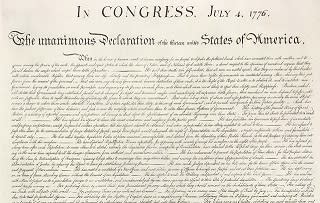What is the Stone version of the Declaration of Independence?
The Stone copy of the Declaration at the National Constitution Center is one of most important Founding Father artifacts. Philanthropist David Rubenstein, who loaned the document to the museum, explains its importance in the October 2013 interview.
The printing also made recent headlines when scholar Danielle Allen, who recently appeared at the National Constitution Center, brought up a controversy about the most-accurate printing of the Declaration, in a New York Times feature.
Rubenstein explained the document to National Constitution Center president and CEO Jeffrey Rosen, which is one of only 50 known surviving copies engraved and printed by William Stone.
“What happened on August the 4th of 1776? They more or less came back more or less at the same time, and they signed it. I think it was 56 or 57 people signed it. And they signed it by state. That document was then the legal copy of the Declaration of Independence. And then it became owned by the US government when the US government went into effect. So it was rolled up from time to time. It was taken to New York. It was taken to Philadelphia. When it was in Washington, DC, and we were invaded by the British, it was rolled up and taken down to Leesburg and hidden. And over a period of time it kind of was getting a little rough. At one point later on in the late-1800s, it was put on display for 30 years in the patent office, and it faded. But before that happened, and in recognition that it probably would fade and probably wouldn’t be something that people could see—remember, there were no copies of it and they didn’t have a Xerox machine. There were no e-mails or anything and no iPads. So how could people see this famous document? John Quincy Adams, when he was Secretary of State, said, “We’ve got to make copies of this document, because we need to have copies so everyone can see it. And this is going to fade.” So he hired a man we referred to earlier, Mr. William Stone, a printer in Washington. And he said to him, “You come up with a process by which we can make perfect copies of this Declaration of Independence before it fades.”
“Over a 3-year period of time he kind of figured out, how can I do this? And he came up with a process that’s still unknown exactly what it is. But the essence of it was that he took a wet cloth more or less, and put it on the original and took off a perfect copy, taking off half the ink with it. He then took it and put it on a copper plate. Two hundred and one copies were then printed. They are called Stone copies. One was sent to each of the living signers—there were only three left—of the Declaration of Independence. One was sent to each state. Certain universities got them. There are probably a limited number of copies left of them. So when you see in the New York Times on the 4th of July a copy of the Declaration of Independence, you’re not seeing the original, because that’s faded beyond recognition. If you go to the archives where it is, there’s nothing that—it’s so faded that you can’t even recognize anything. What you’re seeing is a Stone copy. And that Stone copy is a perfect replica of it. And the reason why I think it is significant is that for people to see it, you can see what the document was that they signed. That’s exactly what it looks like. And it helps remind you of that period of time. It doesn’t have any significance other than it’s a reminder of the significance of it. And I hope it reminds people to think about the freedoms and what led to the Declaration of Independence. So that’s the history of it, more than you wanted to know.”
Back in 2003, the National Archives also wrote about the importance of the Stone version.
“After the War of 1812, there was a resurgence of patriotism. The events of 1776 were more than thirty-five years past. The signers were aging, and many had died. Americans had begun to revere the parchment document that signaled the birth of the American nation,” the Archives said.
Two entrepreneurs, John Binns and Benjamin Owen Tyler, each saw a market for selling large prints of the Declaration, and their actions led Adams to commission Stone to do his version.
In 2012, the Archives described how it was still hunting for Stone versions of the Declaration, and it had turned up several more versions, including one that belong to President John F. Kennedy.


